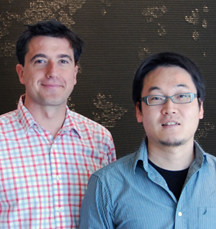Scientists Discover How Chromosomes Keep Their Loose Ends Loose
We take it for granted that our chromosomes won’t stick together, yet this kind of cellular disaster would happen constantly were it not for a protein called TRF2. Now, scientists at The Scripps Research Institute (TSRI) have discovered key details of how TRF2 performs this crucial chromosome-protecting function. The finding represents a significant advance in cell biology and also has implications for our understanding of cancer and the aging process.
“Cells tend to interpret their chromosome ends as sites of DNA damage, and without TRF2, they would attempt to ‘repair’ these sites by fusing different chromosomes together,” said TSRI Assistant Professor Eros Lazzerini Denchi. “The prevailing view has been that TRF2 has a passive role in hiding chromosome ends from the DNA repair machinery, but we found that it also actively suppresses the repair response.”
Lazzerini Denchi is the corresponding author of the new study, which is reported in an Advance Online Publication of the journal Nature on February 6, 2013.
A Protective Cap
TRF2 is part of a protective protein cap localized at the ends of chromosomes, the telomeres. Telomeres shorten with every cellular division, and when they become too short—in aged organisms, for example—TRF2 is no longer able to localize at chromosome ends. In such cases, chromosome ends become exposed and the DNA repair response is liable to knit uncapped chromosomes to each other. This action results in strings of chromosomes fused together that are unstable and can lead to cell death or, in some cases, to uncontrolled growth leading to cancer.
In 2007, as a postdoctoral researcher at The Rockefeller University, Lazzerini Denchi found that TRF2 works in part by blocking a particular signaling pathway in the DNA damage response. In the new study, he and his laboratory colleagues at TSRI have explored TRF2’s functions in more detail.
“We found that TRF2 uses a two-step mechanism to protect chromosome ends,” said Keiji Okamoto, a postdoctoral fellow in Lazzerini Denchi’s laboratory who was the lead author of the new study.
TRF2 is a complex protein with four functional domains (regions). Okamoto probed the specific functions of these four domains by creating artificial TRF2-like proteins—in which one or more functional domains were replaced with non-functional “dummy” domains. By studying how these artificial TRF2s functioned in cells, he could determine the separate functions of each individual domain.
Uncovering Distinct Roles
Two of these domains turned out to have distinct roles in suppressing the DNA damage response. “One domain, called TRFH, blocks localization of the DNA damage factor γH2AX, the initial step in the DNA response pathway,” said Okamoto. It may do so by inducing a structural change in telomeres that hides it from the DNA damage machinery. A distinct region of TRF2, which Okamoto dubbed iDDR (inhibitor of the DNA damage response pathway), independently and actively suppresses the transduction of the DNA damage signal downstream of γH2AX.
Okamoto and colleagues found that the iDDR region works in part by recruiting an enzymatic activity associated with the tumor suppressor protein BRCA1. Defects in BRCA1 lead to DNA misrepairs, genomic instability and a sharp rise in cancer risk. (Certain BRCA1 mutations bring a greater than 50-percent lifetime risk of breast or ovarian cancer.) This new finding hints that BRCA1 defects may result in defects in telomere protection, too.
Lazzerini Denchi, Okamoto and their colleagues now plan to explore TRF2’s functions and protein partners in further detail, in cell studies and in transgenic mice. “We want to address the BRCA1 connection more thoroughly, too, for example, to determine the importance of its association with telomeres in preventing tumors,” Lazzerini Denchi said.
The other contributors to the study, “A two-step mechanism for TRF2-mediated chromosome end protection,” were Cristina Bartocci and Iliana Ouzounov of Lazzerini Denchi’s laboratory and Jolene K. Diedrich and John R. Yates III of the Department of Chemical Physiology and Cell Biology at TSRI. For more information, see http://www.nature.com/nature/journal/vaop/ncurrent/abs/nature11873.html
The study was supported in part by a Pew Scholars Award, the Novartis Advanced Discovery Institute, the National Institutes for Health (AG038677), the National Center for Research Resources (5P41RR011823-17) and the National Institute of General Medical Sciences (8 P41 GM103533-17).
Send comments to: press[at]scripps.edu














